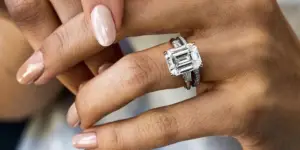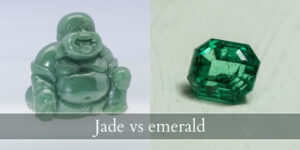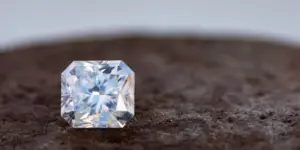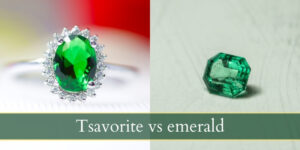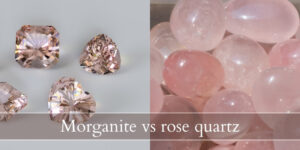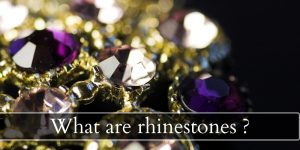Diamond clarity is one of the few things that you cannot easily judge on your own, and thus you will always need a magnifying glass and/or a clarity report from a reputable source. Most of the time a diamond will appear quite clean, since the very included ones aren’t sol das regular white(colorless) diamonds, but instead as salt and pepper diamonds. More on that later. For now let’s focus on exactly how important clarity really is in a diamond, what it does, and whether you should ever splurge on the top tier clarity ones.
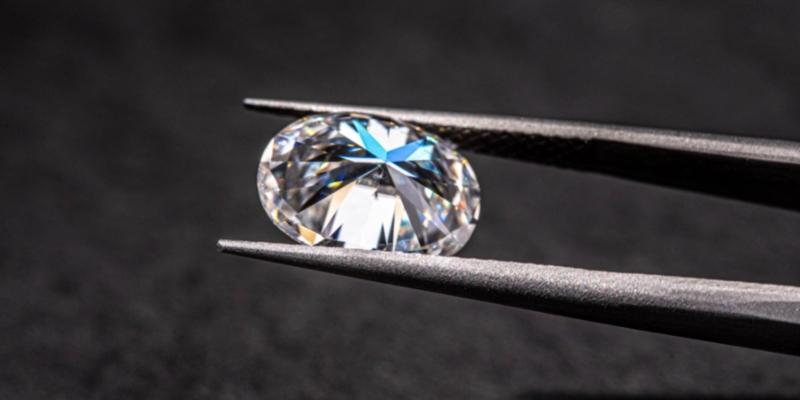
Is diamond clarity important ?
Yes, a diamond’s clarity is important for light performance and overall appearance, including color. It affects the way the light bounces through the gem, the overall color of the diamond, bowties, or dark spots. A well placed tiny inclusion can make a colorless diamond appear grey when viewed face-up, and a skilled lapidary will cut the diamond in a way that hides the inclusion as much as possible.
A heavily included diamond will not sparkle as much as even a medium included diamond. So for example an I3 diamond (the heaviest inclusion grade for clear diamonds) will have a very poor performance when compared to an SI1 (the beginning of the noticeably included diamond grade). Both of them perform less than a VS1 diamond, which is one of the most common diamonds you will see in engagement rings.
In the grand scheme of things however, cut quality is more important than clarity since cut quality can make or break a diamond, regardless of its clarity. This doesn’t mean you shouldn’t get a high clarity diamond, but it does mean you shouldn’t get hung up on its clarity rating. Look at cut and color as well.
Inclusions or blemishes ? You will hear about these two words a lot when discussion clarity, so here’s what they are. An inclusion is a tiny piece of another material, usually graphite, that is stuck within the diamond (included in its structure). They are present since the diamond was formed and usually don’t extent to the surface of the diamond.
A blemish is a tiny, tiny nick, chip, scratch on the very surface of the diamond. These are usually the result of the diamond being cleaved, cut, and set.
Read also: Hoop VS Stud Earrings
What is diamond clarity ?
A diamond’s clarity is the presence of lack of tiny inclusions within the diamond itself. Diamonds with no visible inclusions are regarded as the best, followed by ones that are only visible under a magnifying glass, and finally there are the ones with inclusions that can be seen with the naked eye.
The most common clarity grading sheet is the one by GIA, the Gemological Institute of America. You can find a very detailed and interactive clarity chart on their site right here. The GIA clarity grades are the ones you’re likely most familiar with, here’s a quick rundown:
- FL – absolutely no inclusions at all, not even under 10x magnification
- IF – a diamond that has no inclusions, only a few tiny blemishes
- VVS1-VVS2 are tiny inclusions that can hardly be seen, even under 10x magnification
- VS1-VS2 are small inclusions that can be seen under 10x magnification
- SI1-SI2 are small inclusions that can easily be seen under 10x magnification
- I1-I3 are very noticeable inclusions and blemishes that affect transparency, color, and light performance
What about the naked eye ? What can the naked eye see ? Unless you are a skilled jeweler you won’t see the difference between a VVS1 diamond and a VS2 one, because all the inclusions are tiny, and only noticeable with a jeweler’s loupe. even then you have to look hard for them.
A diamond’s clarity drives the price up or down
Even if you can’t easily see the difference between all these clarity grades, they still affect the overall price of the diamond you buy. In general the higher the clarity the more expensive the diamond. But this isn’t the case for all diamonds, and a diamond’s price is also dictated by its color grade, carat weight, and cut quality. So the clarity is just 25% of the price.
The price for a 1 carat round brilliant diamond drops by about $1,000 per clarity grade, the further down you go. The only exceptions are difference between FL and IF diamonds is almost nonexistent, and the drop from IF to FL is around $500. This was done by comparing the prices for an F color round brilliant diamond weighing exactly 1.00 carats (standardized).
Read also: Moissanite VS Lab Grown Diamond
Not all diamonds work the same though. Brilliant cut diamonds and step cut diamonds work very differently, and which you get can significantly impact the price. Here’s why.
Step-cut diamonds rely heavily on clarity
Step cut diamonds are the ones cut into geometric shapes, less facets the the usual brilliant cuts, and they allow you to look directly into the diamond itself. There are far fewer facets so less chances of distorting the image, which means ay imperfection present on or in the diamond will be very noticeable.
This means that step cut diamonds will not conceal a clarity lower than VVS2, because you might just see it with the naked eye if you look close enough. This means that if you’re looking at step cut diamonds and your budget doesn’t allow you a high clarity one (VVS2 and above) you have to be very careful where exactly the inclusions are in the diamond. This video (link opens in Youtube) explains SI1 inclusions in emerald cut diamond, and gives three examples of included diamonds.
Brilliant cut diamonds may conceal minor imperfections
Brilliant cut diamonds are the classic sparkly diamond we all know and love, and the one you know best is the round cut brilliant. it’s the typical diamond in an engagement ring, and the one that does, in fact, sparkle the most.
The great thing about this style of cuts (brilliants, not necessarily rounds) is that they tend to be lenient when it comes to color and clarity. You can go a whole grade lower than with step cuts, so a radiant cut for example will still look great in VS1-2 clarity. The only ones you might have to watch for are pear cuts, marquise, and princess cuts. This is because they have sharp, shallow points that may sometimes have inclusions and those will be noticeable.
Does clarity affect sparkle ?
Yes, a diamond’s clarity also affects its sparkle. A clear diamond has little to no inclusions, which means there is nothing to obstruct the light as it travels through the diamond. This means optimal light performance, the diamond doesn’t appear grey or dulled/hazy.
The bigger issue for a diamond’s sparkle is its cut quality. The cut quality can make the diamond leak light, have dark spots, appear too bright, or simply be spectacular, all depending on how well the diamond itself was cut. This is more important than clarity and si the one thing we recommend you don’t compromise on.
What is the minimum clarity for a 1 carat diamond ?
The minimum clarity for a 1 carat round brilliant diamond is usually VS2, since this clarity level doesn’t usually affect the overall look of the diamond. This level of inclusion isn’t usually seen with the naked eye. Most lapidaries will cut the diamond in a way that the inclusion won’t be reflected everywhere. The round brilliant is the usual diamond you see in engagement rings, so if this is what you were looking for, know that you can go pretty low with this cut style.
Now if the diamond in question is a step cut you want to stop at VVS2 and not cross into VS1 since it might be noticeable if you look hard enough. Here’s a video (link opens in Youtube) showing you three step cut diamonds with VVS2-VS1 clarity.
Of course, these are all just guidelines. The way a diamond behaves in person will determine whether you actually like it or not, not the specs on the report. You might find a radiant cut SI1 and fall head over heels for it, regardless of the inclusions. Sometimes the inclusions are extra contrast, and for some people that is a bonus.
Does anyone actually buy SI1-2 diamonds ?
Yes, SI1 and SI2 diamonds are still a good option for some diamonds or jewelry pieces. These clarity grades mean the diamond has a small but noticeable inclusion, one that might even be seen with the naked eye. In a step cut it would be too glaring, but in a brilliant cut the many, many facets are going to diffuse that inclusion and make it look actually nice. Of course, this depends on where the inclusion is and what it looks like, some can’t be helped.
But an SI diamond can really be beautiful, especially if you’re into grey diamonds. In some cases the inclusion reflects into the rest of the diamond and gives it a grey cast. Other times it just provides a very striking contrast within the diamond.
SI doesn’t really work for very large diamonds. If you do get this clarity, you want something at 1 carat or under, and if it’s something like a necklace or bracelet (several diamonds strung together) you should opt for smaller diamonds, so the inclusions are less noticeable. Also if you’re going for several diamonds at once, make sure you’re getting them the same color and clarity.
Is it worth buying FL and IF diamonds ?
FL and IF diamonds are premium diamonds that perform not much better than the more affordable VVS1-2 diamonds. The main difference between FL+IF diamonds and any other is that there is no physical inclusion that can be seen under 10x magnification, within the body of the diamond, and some people like having that guarantee of absolute, pristine clarity.
If you’re showing off a large diamond, such as a 5 carat emerald cut, then inclusions will be easier to see and FL and IF diamonds are a safer bet. But you could easily get away with a VVS1 clarity one, and for a good few thousand $ less.
So is it worth splurging on the FL or IF diamond ? For most people no, it’s not worth it. Most people will not notice the difference in clarity. If you want to own something premium and feel that the difference in clarity is worth it, then by all means go ahead. There’s something to be said about an absolutely perfect diamond, after all.

I’m the main author for jewelrymaterialguide.com. I started this site after we did tons of research before our wedding and noticed that there is information about rings, jewelry, and so on that is really hard to find on the internet.

